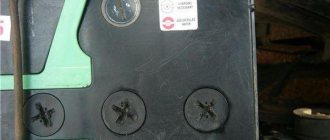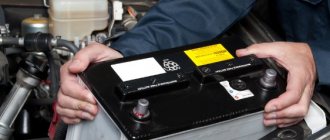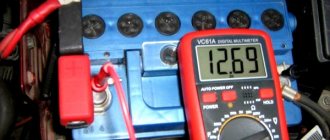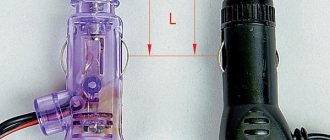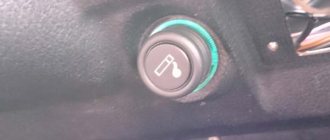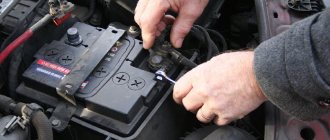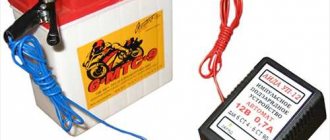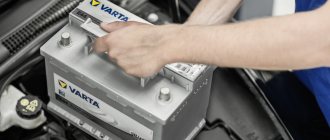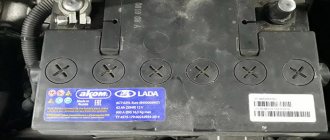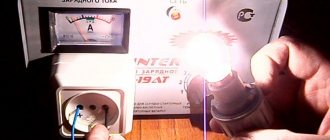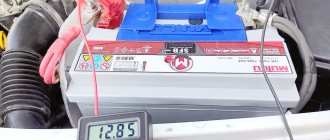- if the value is positive, it means that the red conductor is connected to the positive terminal;
if the value is negative, then a black wire was connected to the current terminal corresponding to “+”.
And then everything is by analogy: starting from the location of the positive rod - the current output, we find out the polarity of the device.
In these simple ways you can quickly determine the polarity of a battery, but at the same time knowing exactly what its direct and reverse characteristics are.
What does direct or reverse polarity mean?
The polarity of the battery, as we mentioned above, can be reverse or direct. Direct polarity was developed for the needs of the Soviet automobile industry. And until now, all cars produced in Russia are equipped with batteries with straight polarity.
Reverse polarity, as you might guess, is used in European, American and Asian cars. The truth is that the car was assembled abroad does not always mean that its battery belongs to the “reverse polarity” group.
What is forward and reverse battery polarity? Direct polarity implies a positive terminal on the left and a negative terminal on the right; in the case of reverse polarity, the positive and negative terminals are swapped.
You should look at the battery from the front side; it can be identified by the label attached, and if there is no label, the front side is considered to be the side to which the terminals are located closest. If the red, positive terminal (can be indicated by engraving on the case) is on the right, then the battery has reverse polarity.
What is polarity?
Polarity is a concept that defines the location of the pole terminals (external current-carrying elements) on the cover or front side of the battery. There are two standard position types:
- Straight.
- Reverse.
But the current leads can be located differently. Such “exotic” batteries have not caught on with car owners in Europe and the CIS countries, so they are extremely rare on store shelves. It remains to find out what the polarity of the battery is, direct or reverse, and whether there is a difference between the batteries.
Straight battery polarity
Batteries of this type were developed by Soviet engineers. All cars produced in the USSR were equipped with direct-type batteries. They are characterized by the following arrangement of pole terminals - “+” on the left and “-” on the right. Batteries are still produced with this arrangement of current leads today. A fairly impressive percentage of vehicles of foreign brands that are assembled in the CIS countries are equipped with a battery with a left “+”.
Reverse battery polarity
Reverse polarity batteries are manufactured by manufacturers in European countries. Therefore, all imported vehicles are equipped with batteries in which the current terminals are located exactly the opposite - “+” on the right and “-” on the left.
How are batteries different?
If we are talking only about polarity, then the only difference is the location of the current leads on the equipment cover. The layout of the polar terminals does not provide any physical or operational features to the battery, but when installing a battery of the wrong polarity into a vehicle, difficulties will inevitably arise with the length of the terminal wires. It does not matter that both the old battery and the new component are made by the same manufacturer. The wires are not long enough! To avoid additional expenses and loss of time on building up wires, it is wiser to immediately select and buy the right type of battery.
If we are talking about purchasing batteries from different manufacturers, then they may differ both in the location of “+” and “-”, as well as in geometry and dimensions.
This problem cannot be solved even by extending or replacing wires, since the mounting location for the component always has strict geometric and physical parameters. The spare part may not fit into the seat. Under favorable circumstances, wrong battery polarity may not be a problem. If you can install it in the socket correctly, turning it 1800. In this case, the length of the terminal wires will be sufficient.
What is a battery and what is it used for?
In order for the car to start moving, it must be started. For such purposes, a battery is used, which provides the engine with energy when it starts. But the car battery also has other functions; new car designs include quite a few devices that require electricity to operate. And the more modern the model, the more electrical appliances it contains. The main values that characterize the operation of batteries are:
- Capacity.
- Dimensions.
- Polarity.
If the capacity is chosen correctly, this will make it possible to simply and without significant complications start the car and use its electrical equipment without thinking that it may fail. If the battery has a smaller capacity than the vehicle requires, its service life will be significantly reduced due to the need to constantly recharge.
The dimensions of the battery play an important role if you choose a battery that is not included in the recommendations of your car manufacturer in order to install it correctly. And of course polarity, which is the most important indicator of battery performance. To use the battery correctly, you need to know what polarity it is.
Polarity is predetermined by the fact that the electrical circuit has negative and positive poles. On the battery, this is expressed by the location of the current leads, which are located on the cover of the device. As a rule, near the terminals, in different ways, whether drawn or glued, the terminal designations: “+” and “-”. The most used circuits that are found on our market are “direct” and “reverse” polarity. Apparently this means that in one case the positive terminal is located on the right, in another on the left. And if, when using a battery, due to ignorance or inexperience, you confuse the polarity, then you will have bad luck. This can cause serious damage to the car, including a fire. It is also necessary to take into account the fact that the length of the wires that are used to connect the battery are calculated specifically for a certain polarity.
Identification of poles in the absence of markings
Positive and negative current terminals are distinguished by signs (plus and minus) or colors. Manufacturers indicate a positive charge in red, and a negative charge in black or blue. Situations where there are no identification marks are quite rare, but still occur in practice. In this case, you can determine the polarity of the car battery in the following ways:
- Measuring the diameter of current carrying elements. The positive terminals are larger. For the European standard size, the diameter of the positive terminal will be 19.5 mm, for Asian - 12.7 mm. To get an accurate measurement, you should use a caliper.
- Experiment with citric acid. In order to determine the location of the terminals, you need to prepare a weak solution and pour it into two glasses. A thin copper wire is screwed to the terminals, the bare ends of which are dipped into the acidic liquid. If active gas formation is observed in one of the containers, there is a negative terminal there.
- Experiment with raw potatoes. To do this, you need to take one vegetable, cut it in half and place copper wires in it, coming from the negative and positive current terminals, at a distance of 1 cm. Green spots will appear near the wire that comes from the positively charged terminal.
- Measuring voltage with a multimeter. It is necessary to touch the current terminals of the car battery with probes and look at the readings. If the multimeter shows a positive charge, then under the red wire there is a terminal with a “+” sign, and under the black wire there is a minus sign. If the device shows a negative voltage, then the positive terminal is located under the black probe.
In order for the car to work properly, every motorist needs to become familiar with the methods of determining battery polarity. To do this, you need to learn to distinguish the markings on the label or use available tools that will help you recognize the location of the current terminals. Having learned this, you can easily determine the European and Russian polarity of a car battery.
How to determine battery polarity
Polarity is an important characteristic of the battery, the value of which determines the location of the terminals on its body.
Any machine has a special cable length that is suitable only for a certain type of battery. If you try to install a battery in your car with the wrong polarity, you risk encountering a lot of difficulties. Either you will have to somehow extend the cables so that the battery can function properly with your car, or it simply will not fit in the body of your car.
If you want to know the polarity of the battery, turn it towards you so that the terminals are closer to you, and look at the location of the current terminals of your battery.
Reverse polarity
The terminals on batteries with reverse polarity are located as follows: the positive current terminal is on the right, and the negative on the left. Another name for batteries with this polarity is European. These batteries are marked with the number “0”.
Straight polarity
If your battery has straight polarity, then its positive current terminal will be on the left and the negative on the right. This type of battery is also called “Russian”. Batteries with this polarity are marked with the number “1”.
Many car enthusiasts may have heard about the “American” and “Asian” polarity of batteries. In fact, this is just a myth, since such batteries simply have a different structure.
In terms of their standard sizes, Asian batteries differ from European ones. They are narrower and longer than the batteries we are accustomed to, and also do not have a “step” on the top of their body, which is why they cannot always fit correctly into the engine of our European cars.
American batteries, in turn, have terminals on the side of the case. To secure such batteries you will need special bolts. There are also special types of such batteries, the terminals of which are located both on the side and on top of the case.
Truck batteries
The peculiarity of “cargo” batteries is that their terminals are located on one of the short parts of the case. To determine the polarity of such batteries, turn the terminals away from you.
If the positive current terminal is located on the left and the negative on the right, then this is European, or reverse polarity. But it, in turn, is marked with the number “3”.
By analogy, if the positive current terminal is on the right and the negative on the left, this is Russian or direct polarity. It is designated by the number “4”.
There are also types of batteries with a layout whose terminals are located diagonally. They are designated by the number "2".
How to determine polarity if there is no marking?
There are cases when you need to understand what polarity the battery is, but the markings on the terminals are either erased or missing. It is quite difficult to face such a problem, but, nevertheless, it is useful to know.
- First, measure the diameter of the current leads. The positive current lead will always be larger than the negative one. Depending on the country of origin, the diameter can vary from 20 to 11 millimeters.
- You can also use a solution of citric acid. Attach copper wires to the terminals, and lower their ends into the solution so that they do not touch each other. After this, violent gas evolution will begin from one of the wires. The contact to which this wire is connected will be negative.
- For determination, you can use raw potatoes. Insert copper wires into its cut at a distance of approximately 7 mm. A small area around the positive terminal should turn green.
Now you know how to determine the polarity of the battery. Feel free to ask questions to our consultants by phone or in our store. All contacts can be found on the site header. Happy driving!
What are the consequences for a car owner when the polarity is reversed?
It is no coincidence that such a difference between batteries is present: incorrect polarity will cause damage to the car’s electronics. The engine control unit may fail and a short circuit may occur.
It is important to remember: not all electrical appliances fail when changing poles. But many will be damaged
Such situations should be avoided.
Moreover, in some cases, the holes in the terminals are even different. Usually the diameter of the positive one is slightly larger than the negative one. Therefore, it will be difficult to confuse them even by accident. Moreover, changing the poles can cause the starter to rotate in the other direction. Some engines may require major overhaul after this.
What to look for when choosing a battery?
We list the signs that will help you make the right choice - and in the future not engage in either extension of power cables or resale of the battery:
- Size. If the dimensions of the purchased battery are not suitable for the car’s socket, further considerations automatically become meaningless.
- Power. Measured in ampere hours. The stronger the vehicle engine, the more powerful the battery required. A battery that is too weak will not last long, and you will experience poor performance throughout its life. Too strong, on the other hand, will not be fully charged by the on-board electrical generator - and will eventually fail too.
- Serviceability. Of course, the best battery models are sealed and maintenance-free.
- Polarity. Must fit the car.
- Cold start current - the higher the current, the better the battery will perform in winter.
What is battery polarity
This term refers to the location of the device's external terminals. In most Russian cars, the most common type of arrangement is straight polarity. That is, if you place the battery with the contacts facing you, the plus will be on the left side, and the minus will be on the right. American car batteries often have the same device. In cars from Europe, it is customary to arrange the terminals in the reverse order, when the positive contact is on the right.
In Asian, for example, Chinese or Japanese cars, the electrodes are placed in the same pattern as on Russian cars. This arrangement, when the negative contact is installed on the left, is called “Asia” or reverse polarity. For this reason, Chinese batteries are usually not installed on German cars. It is also rare to find cars from China with batteries from Germany.
It is important to remember that Asian or European batteries may have different polarities. At the same time, batteries are often similar in appearance and have the same technical characteristics
In the USA, the contacts are placed on the side surface of the box, while in other countries it is customary to place them on the lid.
Since straight polarity was invented in the USSR, it was often called Russian. In a store, instead of the classic classification, the seller can use the names “battery with right plus” and “left plus battery.” To see what polarity is, you should watch the video, which describes the structure of the battery:
Battery polarity
Polarity refers to the arrangement of current-carrying elements on the top cover or front side of the battery. In other words, this is the position of the plus and minus. The current leads are also made of lead, as are the plates inside.
Direct and reverse polarity
There are two common layouts:
- straight polarity;
- reverse polarity.
Straight
During the Soviet period, all domestically produced batteries were with straight polarity. The pole terminals are arranged according to the diagram - plus (+) on the left and minus (-) on the right. Batteries with the same circuit are still produced in Russia and the post-Soviet space. Foreign-made batteries that are made in Russia also have this terminal arrangement.
Reverse
On such batteries, the minus is located on the left and the plus on the right. This arrangement is typical for European-made batteries and therefore this polarity is often called “Europolarity”.
Accumulator battery
The different position schemes do not provide any special advantages. It does not affect the design and operational features. Problems may arise when installing a new battery. A different polarity will force the battery to change position and the wire may not be long enough. Also, the driver can simply mix up the contacts, which will lead to a short circuit. Therefore, it is important to decide on the type of battery for your car when purchasing.
Is it possible to change the polarity of a battery?
It is impossible to change the location of the electrical terminals on the battery case, but on some cars it is possible to install a different type of battery. In this case, it is enough to rotate the battery 180 degrees so that the corresponding leads coincide with the terminals.
This method of connecting a battery with an inappropriate arrangement of electrical terminals may not be suitable only for very short wires that come from the ground of the car and the engine generator. If the car wires connected to the battery are too short to install a part that is inappropriate for the location of the terminals, then it is enough to replace them with a longer wire. In this case, the diameter of the wire should not be less than the dismantled wiring element.
When welding a structure using direct current, it is important to know that the quality of the seam will depend largely on the settings of the machine. An important nuance is that in addition to the current regulator, it is necessary to select the correct polarity
There can be only two types - direct and reverse polarity when welding with an inverter.
Changing battery polarity
Reversing battery polarity can happen accidentally or intentionally. If you mix up the terminals when lighting a cigarette, there are material costs for both the donor and the acceptor.
If you accidentally changed the polarity in your car, then at best the main fuse will burn out, at worst - the diode bridge. The faster you notice the jamb, the less the loss.
Changing the polarity, like reversing the polarity, is used to restore the functionality of a sulfated battery. The battery eats lead sulfate with appetite, cleaning the plates. But polarity reversal means the battery operates contrary to the rules. The forced measure must be temporary. It is much better to use a double polarity change when desulfating.
Why is polarity reversal used?
It happens that when you try to start the engine, the starter barely turns or refuses to work at all. Moreover, just recently the battery was fully charged.
Or there is another situation when the battery is connected to a charger to compensate for the lost characteristics, but literally immediately after applying current and voltage, the effect of electrolyte boiling occurs.
Such phenomena indicate a high probability of severe sulfation of the plates. Lead sulfate is presented in the form of a white coating that covers the surfaces of lead working plates in batteries.
That is, during sulfation, charging occurs only with the participation of those plates that have not yet been covered with sulfate. For this reason, the electrolyte begins to boil very quickly after charging begins, and the accumulated charge itself cannot be maintained for a long time.
For severe sulfation, you can choose one of two options:
- dispose of the old battery and purchase a new battery;
- try to restore the battery.
Now there are chargers with a desulfation mode, as well as special desulfators. But one of the methods of combating sulfation is polarity reversal.
It is about reversing the polarity of car batteries that many drivers who are faced with the problem of sulfation are interested in learning about.
It is recommended to use polarity reversal only in extreme cases. This is a method used only in situations where other desulfation methods do not help or cannot be used.
At the same time, the essence of the method is more than simple and understandable. The idea is to swap the terminals of the battery and charger.
That is, the plus needs to be connected to the minus, and the minus to the plus.
When the poles are changed during charging, the reverse process begins. This provokes the gradual destruction of lead sulfate. Thus, the white coating crumbles and dissolves.
But it is important to be extremely careful, since not all batteries can always be restored using this technique
Types of battery charging from a mains charger
There are several types of charging using a 220 V charger:
- At constant voltage.
- At constant current.
- Combined method.
- Small currents.
- Fast (express) charging.
Constant voltage charging
Constant voltage charging, in theory, is the most correct method for batteries. The voltage is constant from 13.8 to 14.5 V (the higher, the faster the charge), and the ammeter readings proportionally correspond to the remaining amount of charge to the full capacity of the battery. If the charger voltage is less than the nominal 12.7 V, the battery will not be charged, and an even greater discharge is possible. As the battery charges, the internal resistance of the battery will increase and the current value will drop.
When fully charged, the entire capacity is “used”, the current strength is zero. In this case, it is impossible to say exactly how long it takes to charge a car battery; it will also depend on the voltage. At 14.4 V per day the battery will take 80% of the charge, at 15 V - 90% and at 16 V - 100%. In practice, charging the battery usually occurs up to 90-95%, and it is already “sluggishly” perceived by the battery when the ammeter reading is 0.2 A. In 1 hour of charging, the battery can absorb 50-60% of the capacity. Then the current drops, and in the 2nd hour charging is even slower, 15-20%. In order to “catch up” the missing 5% at 0.2 A, it will take another 10 hours.
Constant current charging
Constant current charging has the advantage that the battery can be charged 100% with this method. The optimal current is considered to be 1/10 of the battery capacity, that is, for a battery with a capacity of 60A/h this will be a charging current of 6 A. The charging voltage should be at least 14.4 V, slightly higher than the voltage of the battery itself. Charging will take 10 hours or more. An indicator of battery charge will be the “boiling” of the electrolyte (gas formation) in all banks. This method requires stabilization of the current strength and monitoring of the process due to abundant gas evolution at the end of the charge and an increase in the temperature of the electrolyte.
To reduce negative impacts, it is recommended to carry out a more efficient two-stage charging mode. At the second stage, when the battery voltage reaches 14.4 V, the current decreases by 2 times (1/20 of the capacity). It is at a voltage of 14.4 V that the process of water hydrolysis begins. When working with modern low-maintenance batteries that do not have access to electrolyte, it is recommended to once again reduce the current by half (1/40 of the capacity). As elsewhere, here you have to choose the “golden mean”. With a lower current, a “deeper” charging of the battery is achieved, but it requires considerable time (more than 20 hours). At higher charging currents, the electrolyte may boil away and the battery may fail.
Combined charging method
The combined “IU” charging method is the most efficient today (I-Ucurrent/voltage). The essence of the method is that first charging is carried out with a constant current, when the voltage reaches 14.4V, the amperage decreases and charging occurs with a constant voltage. On modern chargers, as a rule, these processes are automated, and human participation is minimized.
Low current charging
Charging with low currents (equalizing) is carried out when it is necessary to carry out the CTC of the battery and to restore the active masses on all grids of the block. When exposed to low currents, the efficiency of the charger increases, and the charging process itself becomes more efficient, since large masses of the active substance are involved and desulfation occurs. The time required is more than 10 hours, since the current value is from 0.03 to 0.5 A. The indicator of full charge will be a constant value of voltage and density of the electrolyte for 3 hours. There is no overvoltage and “boiling” of the electrolyte.
Fast charging (express charging)
Forced (express) charging is used in cases of extreme necessity, since the battery “tolerates” such loads very poorly, active wear of the plates occurs, its service life is reduced and it can completely fail. If the discharge reaches more than 50%, then this method is useless. Fast charging allows you to use the battery and start the car in 20-30 minutes. The current strength in such charges reaches up to 70% of the battery capacity. In such cases, it is still better to use a starting device or “light it” from another battery.
Consequences of incorrect connection
In the practice of auto electricians, there are various cases of battery polarity reversal (incorrect polarity setting). In most cases, it is a consequence of ordinary inattention and haste.
Sometimes during the operation of the car, wires connecting the battery terminals of a different color are installed, which can also lead to an error.
There are cases of incorrect charging. If the battery is almost completely discharged, then there is a possibility of charging the battery in reverse polarity using a charger if its terminals are reversed.
Let us analyze the consequences of incorrect polarity in order of their significance.
Generator failure
Occurs in 90% of cases, especially when the battery is well charged. May cause electrical fire.
Most likely, one of the arms of the rectifier bridge (two diodes) in the generator fails. Sometimes two or three pairs of diodes can break through. When the polarity is reversed, it turns out that they are connected in a direct connection, a large current flows through them, they break through. A broken diode has almost zero resistance. In this case, a huge current flows, which can cause a fire in the electrical wiring or damage the battery.
Some manufacturers include a fuse in the generator circuit to avoid such situations. In any case, if a polarity reversal occurs, it is necessary to check the generator.
Damage to electronic control units
The engine control unit is the most sensitive in this case. If it fails, the engine stops starting. Most manufacturers include power protection in control units in this case and in case of malfunction of the generator.
Usually it is a powerful zener diode connected in parallel to the supply bus. It breaks through when the polarity is reversed and the generator voltage is increased. Repairing the unit consists of replacing this zener diode. In an emergency, you can simply bite out the zener diode, and the unit’s performance will be restored.
Blown fuses
This is a more harmless malfunction. Typically, up to 20% of all fuses installed in the car blow out. Therefore, after reversing the polarity, you should methodically check absolutely all the fuses, from powerful distribution fuses in the engine compartment to interior fuses. Fuses should be replaced with similar ratings, never larger, otherwise they will be ineffective.
After checking the generator and replacing the fuses, reconnect the battery and test run the engine. If the car starts, let it run for ten minutes, then check the degree of heating of the generator. If it has increased its temperature significantly, it means that the diode bridge is broken and the generator definitely requires repair.
Next, they check the performance of all electrical components and systems of the car: ABS unit, air conditioning, climate control, body control, lighting, brushes, car radio, and so on. If everything is in order, during the first trips after polarity reversal, check for the presence of foreign odors in the cabin and engine compartment.
Is it possible to set a different polarity?
Theoretically it is possible. But, as stated above, this can lead to unnecessary waste of money and additional hassle with placement in the socket, the length of the wires, and mismatched terminal diameters. It's another matter if you connect the new battery incorrectly. This can lead to serious consequences. Therefore, if the technical documentation indicates that the car requires straight polarity of the battery, it is wiser to buy a battery with straight polarity.
What will be the consequences if the polarity is reversed when connecting?
- generator breakdown;
- overheating of the diode bridge;
- failure of diodes (accompanied by a pop when the case is destroyed, a smell);
- failure of on-board electronics;
Important! Most electronic devices have reverse polarity protection.
But not powerful consumers of electric current - amplifiers, radio tape recorders. They contain elements, such as capacitors, that are extremely sensitive to polarity reversal. Their failure is guaranteed due to heating. Initially, as the temperature rises, the capacitor will swell and then explode. The process will be accompanied by a characteristic sound and smell.
- failure of the relay in the wiring;
- short circuits in the network, etc.
Determination of magnitude
To be able to accurately determine the type of polarity at a glance, it is enough to pay attention to one of the two opposite signs. https://www.youtube.com/embed/8NDkZECcNvM. https://www.youtube.com/embed/8NDkZECcNvM
When marking batteries, special numbers are used. For example:
- Straight polarity of the battery is marked with the number “1”. Such batteries are installed in domestically produced cars. Today the Lada Priora is equipped with them.
- Reverse battery polarity. Marked with the number “0”. It is usually present in batteries of foreign-made cars. Of course, this arrangement also occurs on our cars, but it happens very rarely.
You can easily make a mistake when purchasing and purchase the wrong battery that you need: for example, buy a battery with direct polarity when reverse polarity is required.
It’s good if the buyer is able to determine this indicator himself: then he will just need to look at the product and choose the one he needs. If a car enthusiast who comes to the store is not aware of what it is and how it is determined, he should turn to the seller for help, who will definitely tell him. To do this, just tell him your model.
Sequence of actions when removing battery terminals
The negative one is removed first, the positive one is removed second. When connected, the order changes: the positive one is put on first, then the negative one. The idea that there is no difference whether it is plus or minus first to disconnect the battery is deceptive. The negative output is connected to the car body. If you first disconnect the red connector, the positive output, when the car owner touches the car body with a tool, a short circuit may occur.
A voltage drop will damage all electrical equipment. If the systems malfunction, you need to know which terminal to remove from the battery to reset the errors. Usually the negative connector is removed and reconnected after 10 minutes.
How to determine the negative terminal
If there are no markings on the battery, you need to know that red indicates a positive terminal, and blue indicates a negative terminal. The plus one is thicker than the minus one. If you mistakenly put the negative connector on the positive terminal, it will be difficult to put on.
The positive one is thicker than the negative one
Possible problems when removing the battery
When equipping a car with an audio system or alarm system, problems with these devices may arise when dismantling the battery.
- Information about switches can be erased from the memory of the electronic unit. The power unit will be blocked.
- All system parameters will be lost.
- If the car has an autostart, it may not function.
- The audio system settings will be reset when the battery is removed. Always before dismantling the battery, you need to make sure there is a system unlock code.
What to do to prevent the terminals from sticking
To ensure that the connectors do not stick due to oxidation, and the car does not suddenly fail, it is necessary to carry out the following mandatory work:
- inspect contacts once a month;
- wipe the surface of the battery dry;
- Every month in the summer, monitor the electrolyte level in the serviced batteries;
- if white deposits are found on the contacts, check the battery tightness;
- before the start of cold weather, you need to check how hot the contacts are when starting the engine; with slight heating, you need to check the contacts and carry out additional processing.
Terminal oxidation
The most effective way to remove deposits on terminals is mechanical cleaning.
To do this, you need to remove the terminals, moisten them with an alcohol-containing liquid or a solvent diluted with water, and wipe them dry. A soda solution (a tablespoon of baking soda per glass of water) will help remove any remaining acid.
A soda solution is used to remove acid residues.
Do not use acetone because it corrodes metal. Sandpaper or a wire brush is suitable for cleaning. The result of the work should be a shiny surface, even if not perfectly smooth.
To keep your contacts shiny, you need to protect them from aggressive substances. The use of lithol, grease and other lubricants will help protect the clamps. Before using the lubricant, you need to remove any remaining material.
Silicone lubricant has proven itself to be excellent, retaining and repelling aggressive media. The disadvantage of the lubricant is its fluidity, it flows out quickly, and it is necessary to inject it regularly. The sprays have proven themselves to be excellent not only in quality, but also in ease of use.
Sprays have proven themselves to be excellent
The idea that graphite lubricant is suitable for contact processing is misleading. The lubricant contains conductive substances.
What does an error in the sequence lead to?
Beginners do not always know which terminal to remove from the battery first. If you do not know in what sequence to remove the terminals from the battery, the device itself and all electrical equipment may fail.
A damaged battery can be replaced with a new one, but replacing the on-board computer will be very expensive. If you first install the negative terminal, secure it, and short-circuit it with a key when installing the positive one, a short circuit will occur. The flow of current will lead to:
- to battery destruction;
- destruction of plates;
- burns of the skin and organs of vision;
- failure of electrical equipment.
Types of battery polarity
Manufacturers produce batteries with six types of polarity. They differ in the layout and integration of battery elements. The most common of these are four types of polarity. Two types are used in batteries for passenger cars and two more for trucks.
Batteries for passenger cars
Before determining the polarity of the car battery, turn it towards you (with the sticker). The battery terminals will be on the top of the battery on the side closest to you. Now we look at the location of the positive (+) and negative (terminal) on the battery. There are two options:
1) The positive current lead is on the right, and the negative lead is on the left. This is reverse polarity or European. It is also designated as “0”. The image below shows a top view of a car battery.
Reverse polarity of a car battery 2) The positive current lead is on the left, and the negative lead is on the right. This is the direct polarity of the car battery or Russian. This type of polarity is also designated as “1”. Below you can see a top view of the battery with straight polarity.
Straight polarity of car battery
Here it is also worth saying about the mythical “Asian” and “American” polarities. These do not exist in nature. There are Asian and American battery sizes. Asian type batteries are slightly smaller in width than European ones, and slightly larger in height. Additionally, they do not have a “step” on the top lid. The terminals of Asian batteries may be thinner, and in some cases they are made for different fastenings.
American-type batteries differ in the type of current leads and their location. The conclusions are not on the top plane, but on the side. They are made for bolt fastening. Although there are models that have pins on the side surface, and standard ones on the top cover.
Asian size
American size As for the polarity, for Asian batteries it is reverse or “0”, and for American batteries it is direct or “1”.
Batteries for trucks
On most truck batteries, the current leads are located on one of the short sides of the battery. To determine the polarity of a car battery, turn the battery towards you with the side with the leads and look at their location. There are also two options here:
1) The positive terminal is on the left, and the negative terminal is on the right. This is the polarity of the car battery, reverse or European. It is designated by the number “3”.
Reverse polarity of the cargo battery 2) The positive terminal is on the right, and the negative terminal is on the left. This is the polarity of the car battery, straight or Russian. It is designated by the number “4”.
Straight polarity of the cargo battery
Cargo batteries can be found in a configuration designated by the number “2”. In this case, the battery current terminals are located diagonally on the upper side.
Diagonal pin arrangement
Other types of polarity
There are two more less common types of battery layout, designated by the numbers “6” and “9”. They are shown in the images below.
Polarity 6
Polarity 9
Determining battery polarity without markings
It happens that you need to find out what polarity the battery is, but there are no markings on its case. In this case, there are other ways to determine:
- Terminal size. If neither plus nor minus is visible from the outside of the case, you should pay attention to the diameter of the terminals: plus, compared to minus, is thicker. If necessary, a minus is connected in series to the battery terminals (the positive must be isolated). It is easy to put the terminal on the minus one, but it will be difficult to get on the plus one. However, this method does not guarantee one hundred percent success;
- Multimeter. This method is more reliable. To do this, the device switches to a mode that measures DC voltages U (limit - 20 V). After this, the black probe of the device is connected to the supposed negative on the battery. The red probe is connected to the second terminal. In the case of positive readings on the multimeter display (about 12 V), it becomes clear that the black probe is connected to the minus, and the red probe to the plus. If connected incorrectly, the device display will display “-12 V”;
- Plaque on the terminals. This is an indirect way to find out whether the battery has reverse polarity or direct polarity. Runs on dead batteries. Here the positive terminal will have a different appearance - this is increased oxide contamination (white or green).
On a note. Before connecting the battery, you need to find out the polarity using any of the above methods.
Difference between direct and reverse polarity of batteries
So, let's sum it up. To connect any battery to the electrical network for charging, two leads or terminals are required. For better reference, the positive terminal is always made thicker than the negative one, in order to eliminate connection errors. The main difference in polarity is the location of the terminals, in one case on the right and in the other on the left. With direct polarity, the positive terminal of the battery is located on the left, with reverse polarity on the right. It also differs in markings. A one is a direct line, if a zero is a reverse line. You may also see the designation l—reverse polarity, R—direct polarity.
How to identify forward and reverse polarity?
Determining the polarity of the battery
Determining the polarity of the product is not difficult. You need to turn the battery so that the front side is facing you. The front side is:
- where the label with characteristics is pasted;
- in which the location of the pole terminals will be closest to the viewer;
- where identification marks and markings are applied.
In most cases, the pole terminals are labeled “+” and “-” directly on the body. If, when you turn the battery towards you, the positive terminal is located on the left, then it is a battery with straight polarity. If there is a “-” on the left, it means the opposite. The marks are generally accepted designations, but they may not be on the body. Equipment manufacturers often use their own markings. For example, pole terminals are distinguished by color. Positive is marked with a red cap, negative with black or blue.
There are also other designations:
- reverse polarity - “0” or “R”;
- straight polarity - “1” or “L”.
Having figured out what the difference is between direct and reverse battery polarity, it will not be difficult to remember the generally accepted symbols. They are valid for batteries produced for passenger cars. When determining the type of battery for buses, trucks and any other heavy equipment that uses batteries with a capacity of 110 Ah or more, the designations will be different:
- the left “+” indicates equipment for European special equipment - reverse polarity;
- the right “+” indicates equipment for Russian special equipment - straight polarity.
Also, when purchasing a battery, you need to take into account differences in the production of cases. Asian battery manufacturers place the pole terminals so that they protrude well above the surface of the top cover. Most European companies make the case more ergonomic, that is, they recess the terminals. Asian devices have significantly smaller terminal diameters than European ones. For comparison, Asia/Europe - “+” output 12.7 mm/19.5mm and “-” output 11.1 mm/17.9 mm.
